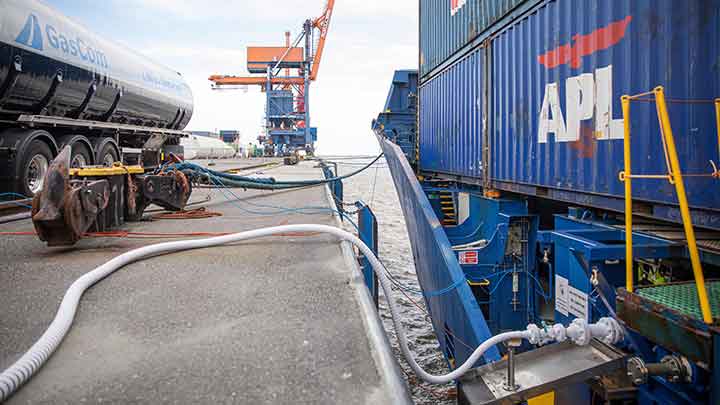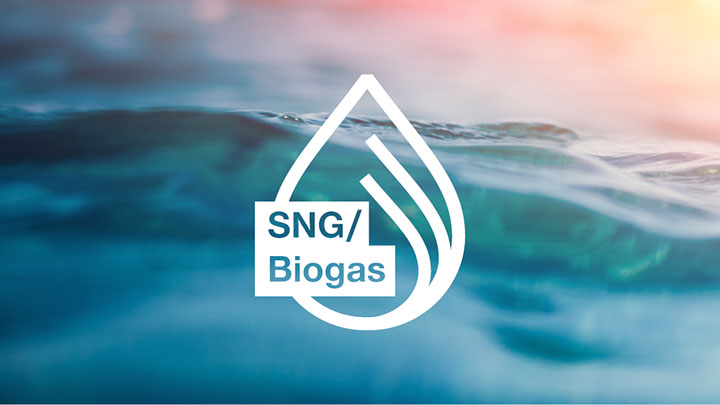SNG: Synthetic gas for the maritime transition

A viable path to decarbonization
MAN Energy Solutions is driving the maritime energy transition with technologies for low-carbon fuels, including green engines and retrofits. Our synthetic natural gas (SNG) solutions offer you a clear path to low-carbon shipping.

From HFO to LNG to SNG
Most of the world's ships run on heavy fuel oil (HFO). The climate crisis has made it essential to find low-carbon alternatives. In recent years, liquefied natural gas (LNG) has become the alternative of choice, but it still a fossil fuel that produces greenhouse gases (GHG). SNG is a new low-carbon alternative. SNG is chemically the same as the main combustible constituent of LNG, so it can used as a direct replacement or blended with LNG, depending on the supply.
SNG as maritime fuel
SNG is optimally suited for the two- and four-stroke dual-fuel engines in MAN’s range and ideal for ships that already run on LNG and aim to save additional emissions. Achieving fuel supply aboard ship is straightforward enough with the right equipment – as with LNG. The new gaseous fuel has to be held at cryogenic temperatures prior to bunkering (-162°C). However, an already established LNG infrastructure can also be used for fueling with SNG.
Reference case: ElbBLUE
World’s first use of SNG in commercial shipping
In September 2021, the 1,036-TEU vessel ElbBLUE, which had been retrofitted with a four-stroke MAN 51/60 dual-fuel engine in 2017, also became the first container ship worldwide to use climate-neutral SNG on a commercial trip. The ship replaced approximately 50% of its bunkered gas fuel with SNG from the Kiwi AG plant in Wertle, Germany. The test proved that any LNG-retrofitted ship can run on carbon-neutral fuels generated by Power-to-X technology.
Read moreManaging Methane Slip
Does the issue of methane slip affect the climate benefits of LNG as an engine fuel for marine applications? Download this paper and find out more about the various countermeasures the company has taken for this purpose.
Synthetic natural gas (SNG) can be derived from fossil fuels and biomass via gasification and methanation processes. SNG can also be produced by, for example, renewable or surplus energy in power-to-gas systems. Biogases are produced from biomass and waste products – and the resulting liquefied fuels can be referred to as BioLNG or LBG (liquefied biogas) and sometimes LBM (liquefied biomethane).
Main advantages:
- SNG and Biogas have the same low NOx, SOx and particulate matter emissions as LNG, but they can be CO2 neutral depending on the feedstock and conversion energy source
- Depending on the source fuel, SNG and Biogas can be a carbon-neutral substitute for fossil fuels
- SNG and Biogas can be blended with LNG to gradually reduce the CO2 footprint
- Considered to be excellent bridging fuels during the ongoing energy transition
Focus areas:
- The availability of SNG and Biogas as bunker fuel
- Increase of production capacities Read more

Solutions / technologies by MAN Energy Solutions:
Two-stroke:
|
|
| Four-stroke: |
|
| Cryogenic equipment |
|
Other future fuels
Related news
World’s Largest Car Carriers Ordered with MAN Energy Solutions Propulsion Package
Chinese yard, Guangzhou Shipbuilding International (GSI), has received an order for 4 × MAN B&W 8S60ME-GI engines in connection with the building of 4 × 10,800 CEU Pure Car and Truck Carriers (PCTCs) for South Korean shipping owner, HMM Co. Ltd.. CSIC Diesel Engine Co. Ltd (CSE) will build the Mk10.5 dual-fuel -GI (-Gas Injection) engines in China, which will feature Exhaust Gas Recirculation (EGR) emissions-reduction technology for Tier III NOx compliance.
Upon delivery, the PCTCs will go out on charter to Hyundai Glovis Co., Ltd., the logistics company headquartered in Seoul, South Korea and part of the Hyundai Kia Automotive Group.
MAN Energy Solutions will also provide the 3 × MAN 8L28/32DF (Dual-Fuel) GenSets aboard each vessel with CSSC Marine Power Zhenjian Ltd. (CMP) set to build these, also in China.
Bjarne Foldager – Country Manager, Denmark – MAN Energy Solutions, said: “We are delighted to secure this order, underscoring MAN Energy Solutions' ability to deliver comprehensive propulsion solutions for cutting-edge PCTC projects. This achievement sets the stage for establishing a market standard in next-generation PCTC vessels, integrating our trusted and proven engines. Winning contracts for both main and auxiliary engines aligns with our strategic goal of providing complete propulsion packages. Congratulations to HMM for their bold commitment to decarbonisation.”
Thomas S. Hansen – Head of Sales and Promotion – MAN Energy Solutions, said: “The car carrier market is currently thriving and demand for new tonnage is at an all-time high. Most of these newbuildings are with dual-fuel engines – on account of new emission regulations – with LNG leading the way as most popular alternative fuel. That said, our main engines here will also be delivered as both methanol- and ammonia-ready. Accordingly, the ME-GI engine remains the most prominent dual-fuel engine in the market with more than 700 orders. It is the world’s most efficient, methane-fuelled engine and has extremely low levels of methane slip, which make it the industry’s leading dual-fuel engine across vessel types such as container vessels, bulk carriers, tankers, as well as car carriers.”
The MAN B&W ME-GI engine
Documents
-
PR HMM PCTCs_EN
Contact
Nils Søholt
Trade Press Marine
Group Communications & MarktingMAN Energy SolutionsTeglholmsgade 412450 Copenhagen SVDenmark
nils.soeholt@man-es.com t +45 33 85 26 69Available languages
- DE ·
- EN
